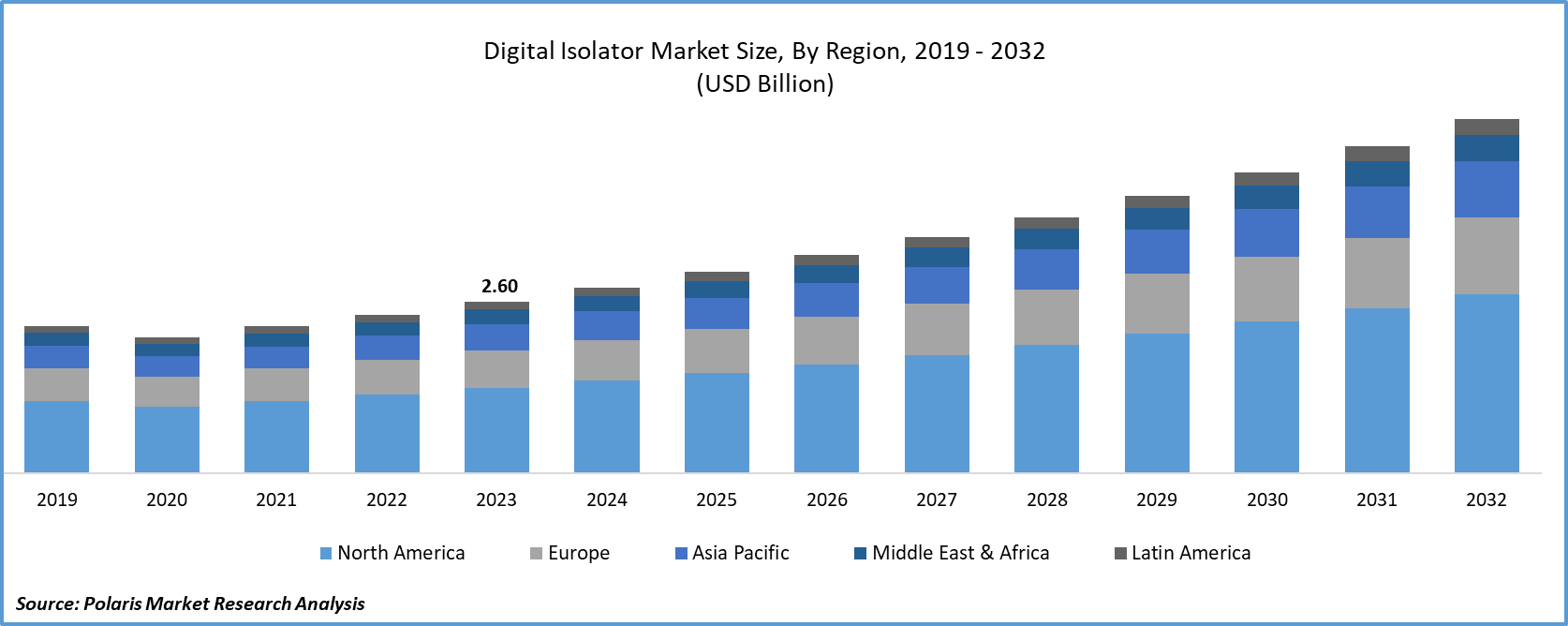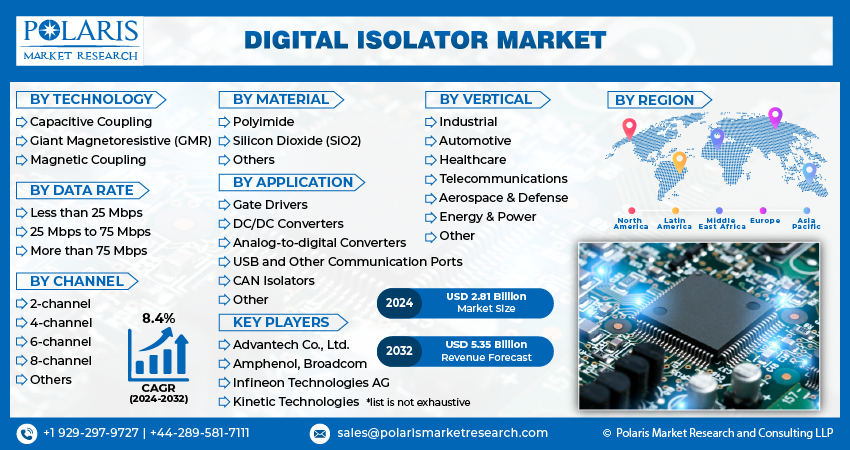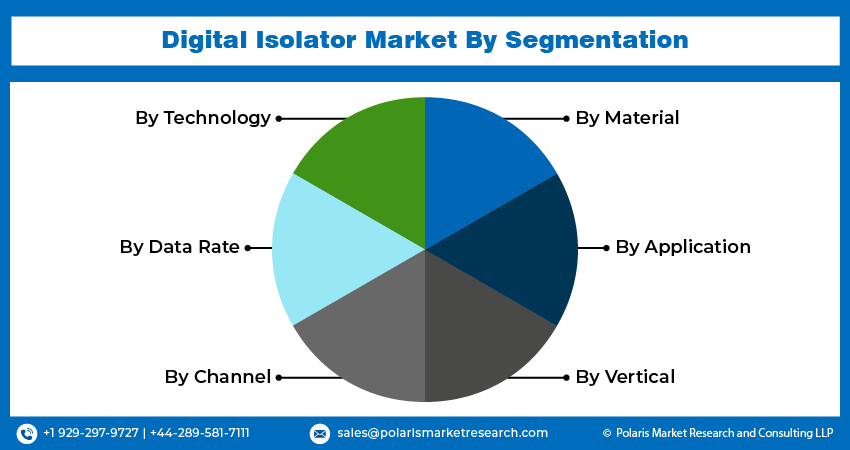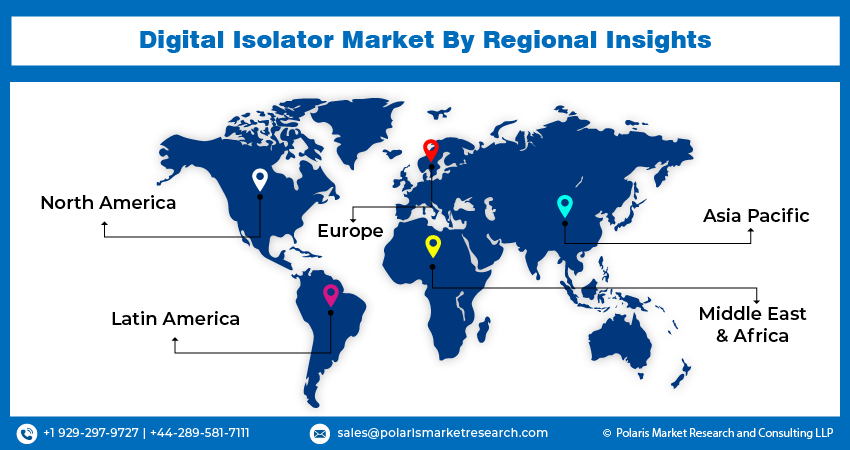
Digital Isolator Market Share, Size, Trends, Industry Analysis Report, By Technology (Capacitive Coupling, Giant Magneto-resistive (GMR), Magnetic Coupling); By Data Rate; By Channel; By Insulating Material; By Application; By Vertical; By Region; Segment Forecast, 2024 - 2032
- Published Date:Mar-2024
- Pages: 118
- Format: PDF
- Report ID: PM4479
- Base Year: 2023
- Historical Data: 2019-2022
Report Outlook
The global digital isolator market was valued at USD 2.60 billion in 2023 and is expected to grow at a CAGR of 8.4% during the forecast period.
A digital isolator is a device used to transfer digital communications by isolating signals over an isolation barrier. These are witnessing significant demand over optocouplers due to their speed, size, ease of use, reliability, performance, integrity, and power consumption. The main factors before continuing with the digital isolator are structure, insulation material, and data transfer method. Designers are adopting isolation because of safety regulations and with a view to lowering noise from ground loops. Digital isolators emerged on the market ten years ago with the potential to reduce penalties and lower the vulnerability of ageing compared to optocouplers. The growing research and development activities among the companies are expected to propel the growth of the market.
For instance, in January 2023, STMicroelectronics developed a high-speed digital isolator called STISO620 with a fast dual-channel facing in the same direction. This is expected to improve reliability in consumer and industrial applications.

To Understand More About this Research: Request a Free Sample Report
Moreover, the advancements in the semiconductor industry in line with the ongoing technological evolution are the major factors that led to the emergence of digital isolators. They play a crucial role in protecting circuits and safety in various tasks.
However, the higher costs associated with the production of digital isolators for automobiles, consumer electronics, and industrial products are expected to impede the growth of the digital isolator market.
Growth Drivers
Escalating Power Safety Concerns in the Market
The growing power safety concerns in the marketplace are driving the adoption of digital isolators, as they prevent electrical hazards with the isolation of high- and low-voltage systems. The high-voltage systems pose risks to the users with a chance of causing damage to other sensitive components, driving their integration into medical and industrial equipment whose probes and armatures run on high voltages.
Moreover, the rising consumer interest in adopting electric vehicles is encouraging producers to design digital isolators for the automotive industry. Power spikes in the electric vehicle can cause fatal shocks and damage electronics in the vehicle, driving the need for effective digital insulators as they can separate low-voltage controllers and ICs from high-power systems like the motor, which can lower the chance of operational failure.

Report Segmentation
The market is primarily segmented based on technology, data rate, channel, insulating material, application, vertical, and region.
|
By Technology |
By Data Rate |
By Channel |
By Material |
By Application |
By Vertical |
By Region |
|
|
|
|
|
|
|
To Understand the Scope of this Report: Speak to Analyst
By Technology Analysis
Giant Magneto-Resistive (Gmr) Segment is Expected to Witness the Highest Growth During the Forecast Period
The giant magneto-resistive segment will grow with rapid pace, mainly driven by its sensitivity and higher accuracy compared to the other coupling and capacitive technologies. The increased switching speed of up to 150 Mbps high-speed data transmission and increased shelf life are the main factors contributing to this segmental growth.
By Data Type Analysis
More Than 75 Mbps Segment Accounted for the Largest Market Share in 2023
The more than 75 Mbps segment accounted for the largest share. The increasing demand for higher-speed data transfer in industrial automation and healthcare fields is driving this growth trajectory in the marketplace.
By Channel Analysis
8-Channel Segment Held the Significant Growth Share
The 8-channel segment held significant growth which is highly accelerated due to its ability to provide multi-stream isolation, making it compatible with complex applications. It enables higher-speed data transmission with increased accuracy, driving its adoption over other channels.
By Insulating Material Analysis
Polyimide Segment Registered Significant Revenue in 2023
The Polyimide segment held a significant market share, which is highly accelerated due to its effective thermal and mechanical properties, superior breakdown strength, and fair dielectric constant. The reliable performance of polyamide insulating material is the primary factor fueling its demand in the market and is expected to continue its growth trajectory during the forecast timeframe.
By Application Analysis
Gate Drivers Segment Dominated the Global Market in 2023
The gate drivers segment held a reasonable growth rate in 2023, which is highly accelerated due to the continuous rise in consumer preference towards hybrid and electric vehicles over traditional fuel vehicles and the increased government incentives to promote sustainable e-mobility. Isolation avoids the undesirable contact between DCs and transients in high-voltage systems. It lowers losses with its high drive strength and fast switching capability, contributing to the growth.
By Vertical Analysis
Automotive Segment Dominated over Other Verticals in 2023
The automotive segment held a significant share in 2023, due to the continuous rise in demand for energy-based automobiles, leading to an increase in the need for gate drivers, necessitating the incorporation of digital isolators in the market. Digital isolators are used to track the battery levels in vehicles and drive efficient electric motors.

Regional Insights
North America Region Registered the Largest Share of Global Market in 2023
The North American region dominated the market. Region’s growth is due to the rising sales of electric vehicles. According to recent data, the United States registered a 67% rise in the sales of electric vehicles in November from September 2023, with 136,000 sales. This trend is the main factor driving the demand for digital isolators in the region and is expected to continue this trajectory in the coming years.
The Asia Pacific region will grow rapidly, owing to the growing consumption of digital isolators. The presence of major players in the region is fueling the expansion of digital isolators. For instance, based on the available data, NOVOSENSE, started mass production of the ultra-wide-body digital isolator NSI82xx-DSWWR in January 2022, and more than 1 million devices have been consumed as of October 2023. This is demonstrating the ongoing upward demand trend for digital isolators in industrial control, energy storage, power supply, and charge piles, signifying a potential need for efficient digital isolators in the region in the foreseeable future.

Key Market Players & Competitive Insights
The digital isolator market is fragmented and is anticipated to witness competition due to the presence of several market players with an increased focus on new product innovations and expansion activities, including mergers and acquisitions, collaborations, and strategic partnerships to gain a competitive edge over their peers. For instance, in 2022, Navitas completed the acquisition of VDD Tech, a Belgian digital isolation company.
Some of the major players operating in the global market include:
- Advantech Co., Ltd.
- Amphenol
- Analog Devices, Inc.
- Broadcom
- Infineon Technologies AG
- Kinetic Technologies
- Littelfuse, Inc.
- Microchip Technology Inc.
- Monolithic Power Systems, Inc.
- MORNSUN Guangzhou Science & Technology Co. Ltd.
- Murata Manufacturing Co., Ltd.
- NVE Corporation
- NXP Semiconductors
- Renesas Electronics Corporation
- ROHM CO., LTD.
Recent Developments
- In December 2023, NVE Corporation introduced its product line with an upgraded version with higher isolation. IL700V-Series isolators are upgraded from six kilovolts to seven kilovolts in the RMS.
Digital Isolator Market Report Scope
|
Report Attributes |
Details |
|
Market size value in 2024 |
USD 2.81 billion |
|
Revenue forecast in 2032 |
USD 5.35 billion |
|
CAGR |
8.4% from 2024 – 2032 |
|
Base year |
2023 |
|
Historical data |
2019 – 2022 |
|
Forecast period |
2024 – 2032 |
|
Quantitative units |
Revenue in USD billion and CAGR from 2024 to 2032 |
|
Segments covered |
By Technology, By Data Rate, By Channel, By Insulating Material, By Application, By Vertical, By Region |
|
Regional scope |
North America, Europe, Asia Pacific, Latin America, Middle East & Africa |
|
Customization |
Report customization as per your requirements with respect to countries, region, and segmentation. |
FAQ's
key companies in Digital Isolator Market are Advantech, Amphenol, Analog Devices, Broadcom, Infineon Technologies
The global digital isolator market is expected to grow at a CAGR of 8.4% during the forecast period.
The Digital Isolator Market report covering key segments are technology, data rate, channel, insulating material, application, vertical and region.
key driving factors in Digital Isolator Market are Rising Focus on Renewable Energy
The global digital isolator market size is expected to reach USD 5.35 billion by 2032
